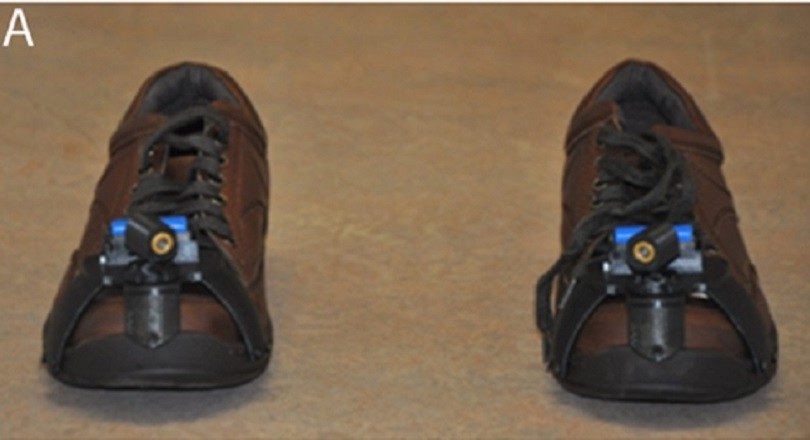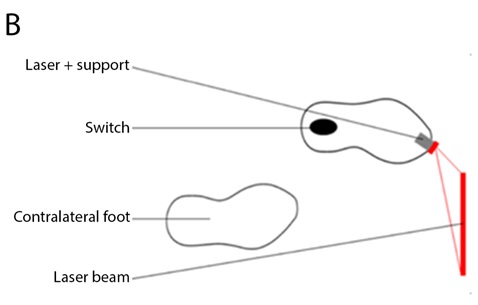
Two shoes which project laser beams on the ground can help Parkinson's patients walk more easily. In a trial of 21 people, the number of 'freezes', in which people are suddenly unable to move forward, was reduced by half.
The research into the shoes, by the Radboud UMC and the University of Twente, was published yesterday in the Neurology magazine. Parkinson's disease is a neurological disorder, which often causes patients to 'freeze' while walking. The problem can be overcome if Parkinson's patients can actively focus on a line on the ground. This is because their brain struggles to cope with automatic movements, whereas conscious thinking processes are still possible. Focusing on the line as an obstacle and concentrating on the movement required to step on or over that obstacle activates different brain circuits, enabling a patient to move forward again.

BORN OF DISAPPOINTMENT
The idea for the shoes came from Murielle Ferraye, whose Ph.D. concerned the effect of deep brain stimulation on freezing among Parkinson's patients in France. 'The operation required for deep brain stimulation is extremely invasive, and apparently only has a limited effect. That was very disappointing, and so I began to look for a better way to solve the freezing problem.’ Together with her father, she then built a prototype of the laser shoes. On arrival in the Netherlands for a post-doc at the Radboud UMC, Ferraye showed the shoes to her superior. 'He thought it was a brilliant idea and wanted to work with it immediately.'
This is a person walking without the laser being activated:
And this is the same person using the laser:
A switch in the sole activates the laser, which is set to project the red line in front of the other foot. 'And so the lasers are in sync with the walking rhythm, which helps keep the patient moving smoothly forward.' The ideal stride length can be set for each patient individually by adjusting the distance between the shoe and the laser projection. 'Or you can train people to take slightly larger steps than normal, which improves their motor abilities.'
READY FOR MARKET
The results of the experiment were so encouraging that Ferraye and her colleagues are now looking into possibilities of marketing the shoes. 'We're also checking whether it's possible to set up a proper clinical test of the shoes.' In the meantime, the technology and the research methodology are also still very much under development. Ferraye: 'It would be fantastic to have an objective criterion for the freezing symptom. In our trial, an independent observer watched the video images of patients and determined how many freezes took place. Ideally if we could detect the episodes using sensors, this would allow us to only activate the lasers when really necessary. That would make it all a lot more elegant.'
Wearing these experimental shoes was apparently not entirely without risk. In 2015, one of the trial participants was arrested by two police officers. According to the police, the shoes resembled explosives, and they therefore assumed that this gentleman was a terrorist. Yet another reason to improve the design of the shoes.
If you found this article interesting, subscribe for free to our weekly newsletter!
Nieuwsbrief
Vond je dit een interessant artikel, abonneer je dan gratis op onze wekelijkse nieuwsbrief.

